By Sudie Hofmann
On a beautiful October day I stood in line to purchase a $17 ticket to enter George and Martha Washington’s estate at Mount Vernon in Virginia, joining the more than 1 million annual visitors, many of whom are schoolchildren. As I looked at the large sign on the wall near the ticket booth, detailing the different tours available, I saw a specialty tour—“All the President’s Pups”—and a special Washington dinner tour. I inquired at the information desk in the Ford Orientation Center about the “slavery tour” I’d heard about and I was provided with a daily schedule that indicated the tour began at 2 p.m. I asked if there was any information in the center about slavery that I could read before entering the “mansion house.” The answer was no.
At the time of George Washington’s death, the Washingtons enslaved 318 people of African descent at Mount Vernon, according to the Mount Vernon Ladies’ Association. But you would not know it from the main tour, nor from the brochure. In fact, most visitors, including schoolchildren, can spend hours admiring the Mount Vernon mansion, fine furniture, and manicured lawns without considering that it was all paid for with forced labor.
The introductory brochure highlights several perspectives: George Washington was the ultimate Southern gentleman; he was a state-of-the-art farmer; both Martha and George enjoyed entertaining; life at Mount Vernon provided an idyllic lifestyle, from the grounds and gardens to the mansion house and outbuildings, to the unimaginable comforts of the time. Slavery is mentioned, but only in one section of the brochure, which directs visitors to the Slave Memorial and Burial Ground.
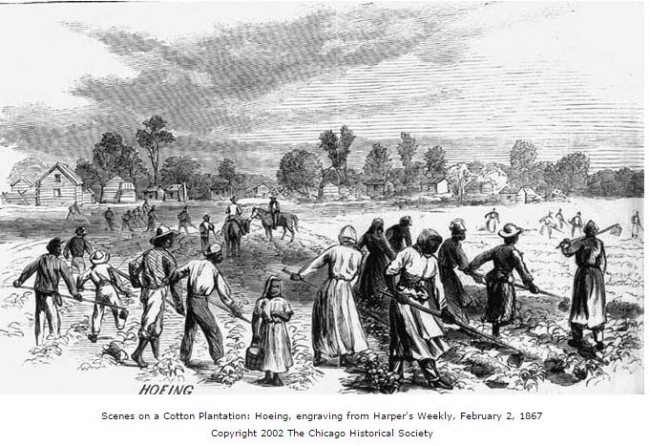
Scenes like this one (while not Mount Vernon) are representative of daily life on many plantations, yet missing from the tour and brochure.
Who Was George Washington?
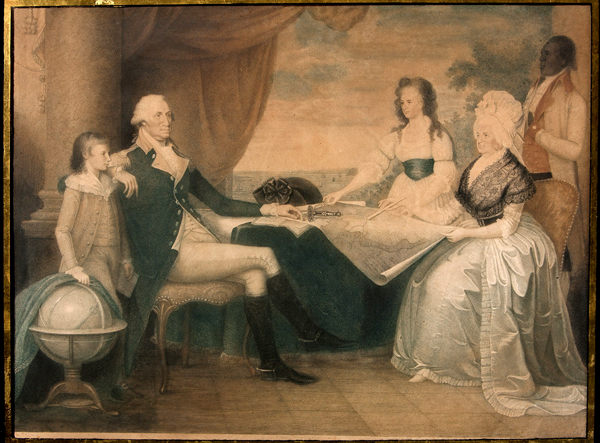
The Washington family. Source: Edward Savage, MtVernon.org.
George Washington is one of the most celebrated war heroes in U.S. history and served as commander in chief of the Continental Army during the American Revolution. He was the first president of the United States from 1789 to 1797. He was also a wealthy land- and slave-owning colonist. His commitment to independence was perhaps motivated more by the opportunities to become even wealthier under independence than an interest in introducing a new concept of democracy to the world. Washington had a lifetime obsession with money, keeping meticulous records of everything he owned, including people.
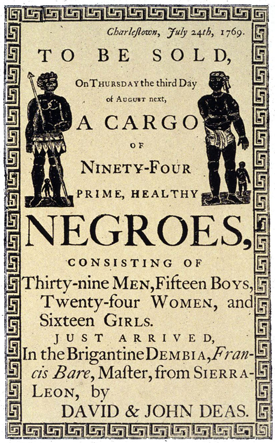 Washington acquired thousands of acres of Ottawa land along the Ohio River illegally from the British as a reward for helping the British in the French and Indian War. He bought shares in the Mississippi Company, a land speculation concern, which stole 2.5 million acres of land from Native people. The great Ottawa leader Pontiac entered into an agreement with the king of England that stated no further encroachment of white settlers would take place west of the Alleghenies. Washington ignored this proclamation after the War of Independence and organized brutal campaigns against the Ottawa in his quest for more land.
Washington acquired thousands of acres of Ottawa land along the Ohio River illegally from the British as a reward for helping the British in the French and Indian War. He bought shares in the Mississippi Company, a land speculation concern, which stole 2.5 million acres of land from Native people. The great Ottawa leader Pontiac entered into an agreement with the king of England that stated no further encroachment of white settlers would take place west of the Alleghenies. Washington ignored this proclamation after the War of Independence and organized brutal campaigns against the Ottawa in his quest for more land.
George Washington purchased people directly from the holds of slave ships. He preferred them to be “strait Limb’d & in every respect strong and likely, with good Teeth & good countenances,” not exceeding 16 years of age if female. Washington wanted genetically healthy girls for reproduction purposes.
While serving as president of the United States, Washington faced a legal problem with the people he enslaved. The capital was moved from New York to Philadelphia in 1791 and the enslaved people who accompanied him to Pennsylvania would be given their freedom if they resided in the state for more than six months. George and Martha Washington kept careful records and rotated enslaved people back and forth to Mount Vernon to avoid being required to free any of them.
Mansion House
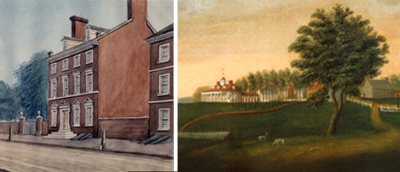
Washington rotated enslaved people between the presidential house in Philadelphia (L) and Mount Vernon (R) to avoid freeing anyone.
Entering the mansion house on the docent-directed tour, visitors were told that the Washingtons loved to entertain. During the first part of the tour, the docent described the food served on elegant china, the dancing that took place and where the men would retire to discuss politics. The docent then escorted visitors through parlors and living rooms where the Washingtons carried out family life and on to the bedrooms on the upper floors where they and their frequent guests slept.
Our tour concluded with George’s study and library and then the docent encouraged us to visit the outbuildings where dairy was processed, fabric was woven, alcohol was distilled, blacksmithing was done, and shoes were made. I use the passive voice here intentionally, because the docent failed to mention the people who actually did this work. When he paused to ask for questions, I asked why there was no mention of the more than 300 people held in bondage at Mount Vernon to make this lifestyle possible. He said, “Oh we make no secret of that. You can visit the slave quarters and find out more about the slaves.” I asked why the tour guides did not mention who performed all the labor when describing the daily activities of the Washingtons. He again directed me to the slave tour and quarters.
Walking Tour—Slave Life
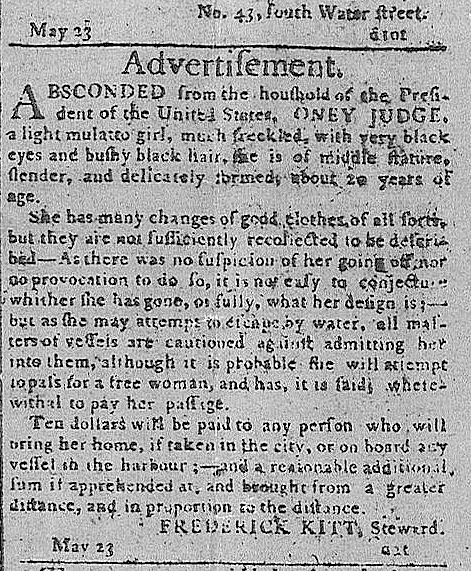
Newspaper ad offering a $10 reward for Oney Judge, who escaped from enslavement by the Washingtons. Click to read text.
A delightful and energetic guide met our group at the Mansion Circle for a 15-minute overview of slavery. The emphasis in this tour, and prevalent throughout the estate, was that the Washingtons were in some ways providing vocational education to the people they enslaved. Returning to the prime motivation for slavery as a profit-making venture, one needs to be cognizant that George and Martha were the ones who reaped the benefits from training enslaved people in certain trades. The profit certainly did not go, in any part, to people held in bondage at Mount Vernon.
Another theme within this tour and the signage throughout the estate was that this was a community of people willingly working toward a common goal, in an almost “whistle while you work” fashion. The astounding inequality was largely ignored. The tour’s narration instead focused on the beauty of the land, the panoramic view over the Potomac, and the warm breezes. The signage and tour create an image of an estate where everyone was happy.
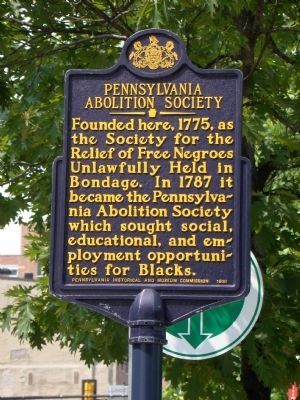
During Washingon’s time, there were a number of groups organized to abolish slavery, including the Pennsylvania Abolition Society.
The guide told tourists that the slaves engaged in trickery with the estate managers when they sang songs in their native languages to warn others that a manager was near. The guide said the slaves would sleep and relax in the shade when no one was around and then the songs would alert them to get up and pretend to be working. He also said, “Slaves could be clever. A new ax could be given to them in the morning and they would make sure to break it by the afternoon. They knew how to get back at plantation owners.” He did acknowledge that there was no “incentive to work” and that being “lazy was OK.” Rather than educating our group about resistance and the need for it, he characterized the men and women as shiftless and conniving.
The guide proceeded to cover the innovative agricultural techniques used on the farm and the high standards Washington demanded. A plaque at the slave quarters states, “The sun never caught George Washington in bed and he was unwilling it should find any of his people sleeping.” At the conclusion of the tour on the front lawn overlooking the Potomac, the guide summarized his message about slavery: “Anyone from the 21st century criticizing someone from the 18th century is being sanctimonious, righteous, and unfair.”
He ignored the fact that during “Washington’s time,” abolitionist groups visited Mount Vernon bearing books and petitions about emancipation, as well as the establishment of manumission societies, humanitarian efforts, writers, and Quaker groups, working to stop the practice of slavery. One needn’t rely on 21st-century critics of slavery; they existed in the 18th century, too.
Slave Cemetery and Memorial
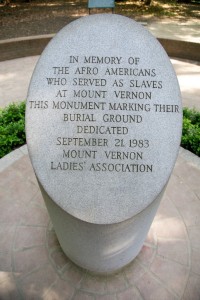
Memorial to African Americans enslaved at Mount Vernon. Source: MountVernon.org.
I walked down a path to the slave memorial and saw a sign asking for “quiet.” I quickly saw that I had entered the area of the Washington family mausoleum. White marble tombs hold Martha and George’s remains. A small crowd of people stood, and listened to the docent’s presentation on George’s family ancestry. There was an aura of awe and respect.
I turned and completed my short walk to the slave cemetery. There was no similar sign that asked for quiet or by extension, respect. Only two other people stood in the area reading the marker designed by Howard University architectural students in 1983. The sign reads “In memory of the Afro Americans who served as slaves at Mount Vernon.” Another grave marker placed in 1929 states “In memory of the many faithful colored servants of the Washington family.” (Italics are my emphasis.)
A New Day
One has to pause and wonder how the Mount Vernon Ladies’ Association can ethically continue to provide these tours at the estate and mansion house and omit mention of any honest representation of slavery and the contemporary consequences of this institution. They perpetuate the “splendid living” and “Southern hospitality” myth in the face of overwhelming evidence that this is false.
The omission of meaningful education about slavery at Mount Vernon contributes to the general curricular silence about the fact that Washington and other slaveholders like him were stealing land, labor, language, and culture from disenfranchised people on a grand scale.
The Mount Vernon tour prevents critical thinking about U.S. history by reinforcing the traditional narrative about slavery and its legacy. This miseducation continues while collecting millions of dollars at the gate to further the myth.
With all the talk of virtue, morality, and principled values on the tour, is it too much to ask that the truth, the full truth, now be told at Mount Vernon?
© Zinn Education Project, 2015

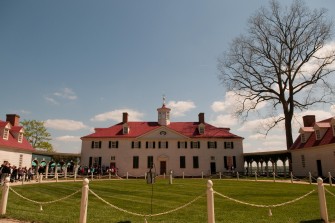
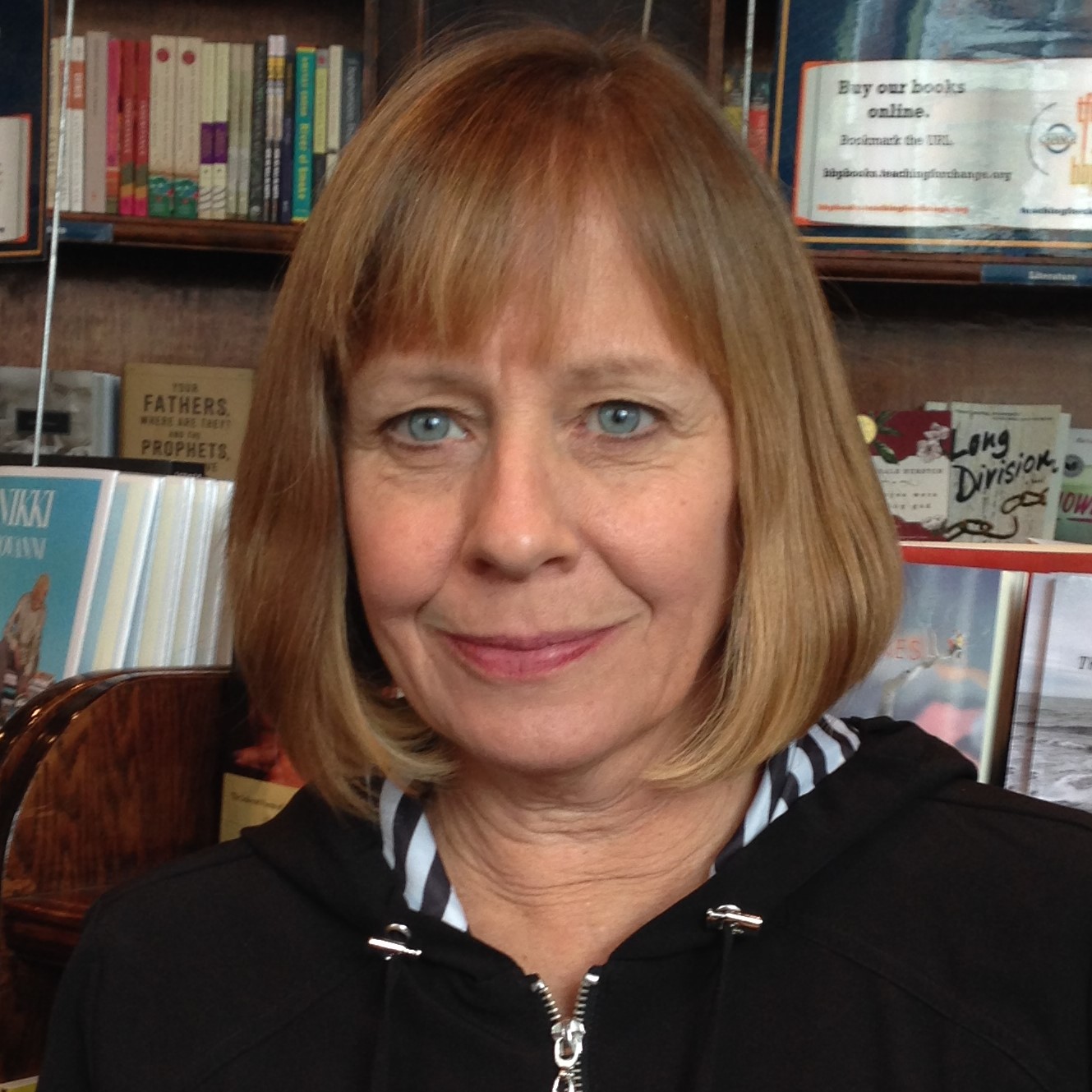
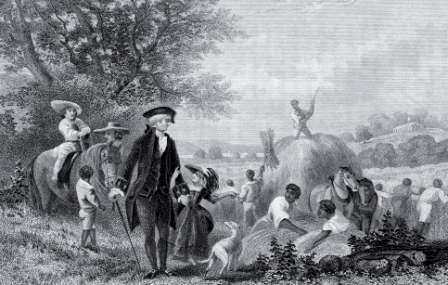
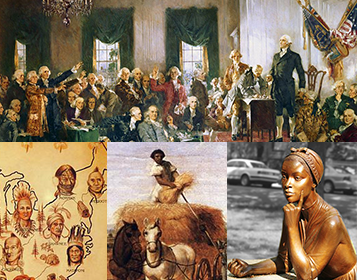
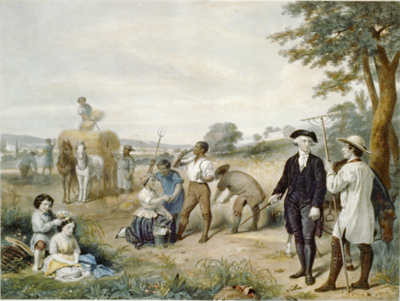
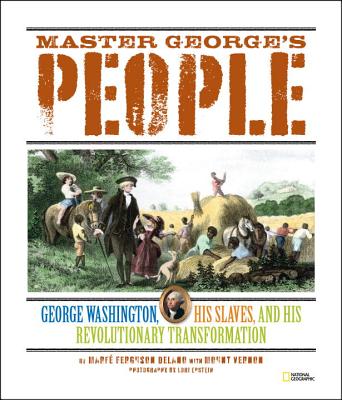
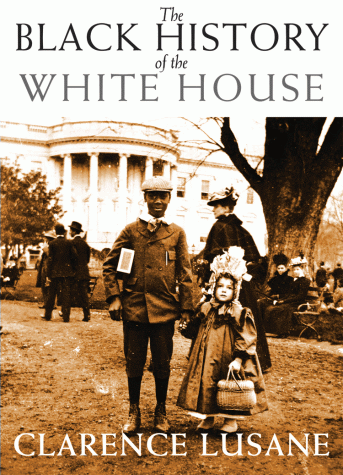

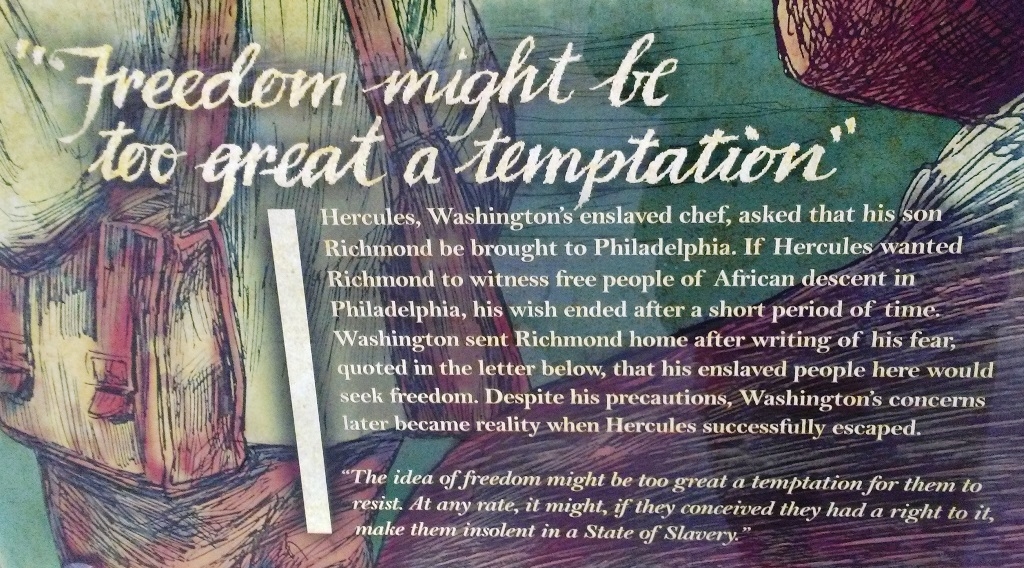





Jen, Hello. I see you visited Colonial Williamsburg in January 2016. I’m thinking that the scarcity of diverse people to be seen at this time or people in general, was due to our pause for employee training. Ordinarily we would have had a lot of folks on layoff at this time, however this year we had foundation wide training and structural management changes as well. However even in full swing we don’t operate showing this town as it would have been peopled day to day. Though we are few in number we are strong in purpose. Please come back and visit again. Go into our trade shops, houses, taverns and listen to put interpreter, if you don’t hear what you were in search of, ask, ask, ask. Go to the Randolph House, the Wythe house, the James Geddy House. Go to the Capitol and Palace and ask about the half of the town who were enslaved and Expect to hear about those people. Ask about the few free blacks who walk the streets there. Ask about evening programming depicting their presence here. Programs such as African American Music, Papa Said, Mama Said, and Affairs of the Heart. Go to the Dewitt Wallace Museum and ask to be shown what represents this part of the population. Also feel free to look for me, Janice Canaday, Adam Canaday, Hooe Wright, Katrina Lewis, James Ingram, Emily James and others who would be happy to assist you in a mire inclusive tour.
Thank you for this article — I just visited the South and returned ever-so-puzzled by the thriving wedding industry on former plantations — all those brides posing for joyous photos seems analogous to an Auschwitz nuptial Albeit Macht Frei.
It is time to examine with a critical eye if the American revolution was more of a self servicing effort by Washington, Jefferson, and Madison to maintain their vast properties and the means to do so (slaves), than the creation of an equalitarian government. England, had forbidden the expansion of slavery and the colonies were already coming under pressure to conform to English law. Current to the times, especially in New England states, there was already an abolitionist movement in place. Our founding fathers could not (anymore than the Confederacy) attempt to stand on traditional values, i.e. slavery, and then espouse the principals of the Constitution. The Constitution is a moral philosophical document – the institution of slavery is not. Either we admit that to espouse both democracy and slavery at the same time is sociopathic behavior, or we admit that greed and selfishness are to be found at both Mount Vernon and Wall Street – past and present.
Thank you for this thoughtful piece. I felt the exact same way on a recent visit to Williamsburg, Virginia. There is one empty building at the edge of Colonial Williamsburg dedicated to African American religion, and supposedly their street theatre includes enslaved people. Considering that 52% of Williamsburg population were enslaved, this is FAR too little.
This article confirms my own impressions over many years of touring the founding fathers’ homes in VA, and in other states. There is an embarrassment and hostility expressed about these people owning human beings. I guess progress is coming slowly as they are now actually admitting that they were slaves, and no longer using the euphemism of “servants” when discussing them on the tours, which they only do when asked. I always ask. At Woodrow Wilson’s home in VA, there is substantial covering up about the slavery Wilson was raised around and the “servants” who were owned by the property. Given that he was a 20th century president, the argument does not hold up that these are 18th and 19th centuries practices. Montpelier is actually reconstructing slave buildings near the “big house.” Much is made about Washington freeing his slaves upon his death but nothing is said about the reason for doing so, taxation for Martha being the cause.
I was a tour guide at Mt Vernon many years ago. They’re hourly workers with absolutely no authority over the content of the tours. There wasn’t a script when I worked there, but there was a clear outline of what topics to include when. It’s a shame you decided to give one of them a hard time instead of addressing it to people who actually make the decisions.
We cannot judge the present by the past, anymore than we can judge what happened in America in the past. The times now are very different and that came about by gradual change. Thus, it is our duty to carry on the job of making our socirty a better one that yesteryear!
Maryann, its beyond perhaps, its a certianty that the truth about Georges slave holdings was buried from the eyes of history.
I don’t think it’s “guilty conscience,” Maryann, but rather perpetuating the myth for power and profit.
Another reference: The Half Has Never Been Told: Slavery and the Making of American Capitalism by Edward E. Baptist
Very enlightening article. I wish that history as is taught in most schools was not one-sided. We may never know the full truth of what awful things were done to people of color, whether African or Native American. Perhaps people with a guilty conscience buried the truth.
Tiffany and Jim, the point of the article escapes you. On second thought, it does not. You conveniently ignore that ugly, painful part of American History, and all the benefits America reaped from such slave policies are white washed from the tour. But this is what many Americans do: turn away shamefully, and pretend everything is OK.
God bless you for writing this article. I plan to read it to my children. The Zinn Education Project is a must have for anyone teaching their children history. I have never visited the Mount Vernon house because I could not bring myself to pay to tour a place where my ancestors were enslaved. Imagine if I had paid and then heard the docent characterize the enslaved African people as “lazy!”
The Mount Vernon website offers in-depth information on various subjects. Including slavery. There are details on those enslaved & on Washington’s changing opinion of slavery. Do investigate. This informative website is partly supported by admission to Monticello.
You failed to mention that George Washington freed his slaves in his will. Those too old or ill to work would be supported throughout their lives; young men would get education & further training to become free Virginians. Alas, slaves that Martha had inherited from her first husband & their descendants could not be freed–they went to her heirs at her death. Alas, the Custis heirs did not share Washington’s beliefs.
Neither did the three of the next four presidents who were also Virginia slaveholders. Washington had hoped to set an example, but Jefferson, Madison & Monroe never freed their slaves. Well, TJ let a few of the Hemings family leave. Jefferson forgot some youthful anti-slavery opinions as he aged–thinking that freed slaves could only be sent outside the US. Which was all too expensive.
I remember this tour well. I went with my Girl Scout troop. It was mid 60’s and it was the first time I saw slave quarters. I was 10 or 11 and was shocked that George had slaves. The ancestors of that place spoke to me, I didn’t want to leave. I saw them running around, working, hauling, getting beat… I wouldn’t leave, they had to come back to get me; everyone was waiting on the bus… It was then that the full impact of institutional racism really hit me. That summer changed my life.
I agree with your commentary however, I think your scope for the tour my exceed the limits of the physical tour to the Slave Courts at Mount Vernon. To supplement, they do offer many courses and seminars.
What is missing is history of where the slaves were from and their names. As property there must have been records of the people that Washington brought off the ships.
Congress should fund the research on identifying the people that were Washington’s slaves.